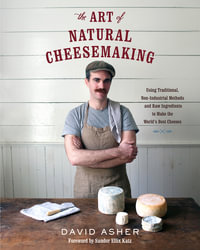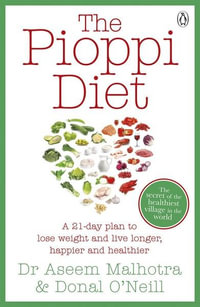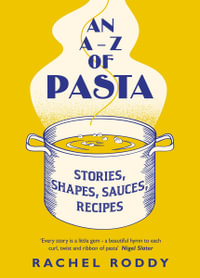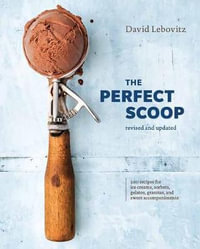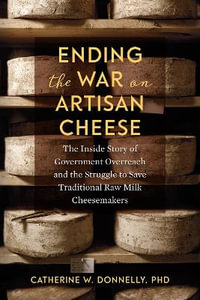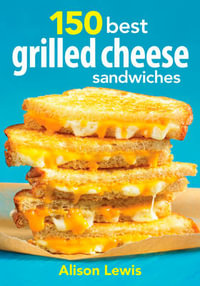
At a Glance
272 Pages
27 x 21 x 1.5
Hardcover
$47.95
or 4 interest-free payments of $11.99 with
orAims to ship in 10 to 15 business days
David's frozen favorites range from classic (Chocolate-Peanut Butter) to comforting (S'mores Ice Cream) and contemporary (Lavender-Honey) to cutting-edge (Labneh Ice Cream with Pistachio-Sesame Brittle). Also appearing is a brand new selection of frozen cocktails, including a Negroni Slush and Spritz Sorbet, and an indulgent series of sauces, toppings, and mix-ins to turn a simple treat into a perfect scoop of delight.
About the Author
David Lebovitz has been a professional cook and baker for most of his life; he spent nearly thirteen years at Chez Panisse until he left the restaurant business in 1999 to write books. He moved to Paris in 2004 and turned davidlebovitz.com into a phenomenally popular blog. He is the author of six books, including The Perfect Scoop, Ready for Dessert, The Great Book of Chocolate, and a memoir called The Sweet Life in Paris, and he was named one of the Top Five Pastry Chefs in the Bay Area by the San Francisco Chronicle. David has also been featured in Bon Appétit, Food & Wine, Cook’s Illustrated, The Los Angeles Times, The New York Times, Saveur, Travel + Leisure, and more.
Industry Reviews
"A glorious, in-depth look into a scrumptious subject, written in typical Lebovitz style: informative, personal, and entertaining."--Yotam Ottolenghi
"The Perfect Scoop digs right into what you need to know for successful ice creams, sherbets, gelatos, sorbets, frozen yogurts, and granitas." --New York Times
"Having churned out ice cream at home and in professional kitchens for a quarter century, Lebovitz can guide even a beginner to a great frozen experience. . . . Truly the Good Humor man of home ice cream." --San Francisco Chronicle
"The author's 25 years of experience as a frozen-dessert maker are put to excellent use in this wittily written, detailed volume. . . . Great photos and plenty of practical advice combine to make this an appealing and useful resource for the dessert aficionado." --Publishers Weekly
"If you love cold sweets but never dared own an ice-cream machine for fear you'd soon weigh 300 pounds, then consider this book; you may just find some happy compromises." --Epicurious.com
Whether you’re a novice or a highly experienced cook, you will find it’s easy to make the freshest, most unbelievably tasty ice creams, sorbets, sherbets, and granitas in your own kitchen. If you’ve never done it before, prepare to be wowed. Nothing beats the taste of freshly made ice cream spooned directly from the machine.
In this chapter you’ll find all the information you’ll need to do it. Starting with step-by-step instructions for making the perfect ice cream custard, I’ll take you through the process--including some pitfalls to avoid and steps to take in case you manage to fall into one of them. The best ingredients and the right equipment are crucial to making really perfect ice creams and sorbets. I’ll give you advice to help you make your choices, including information about the differences among various models of ice cream makers, if you don’t have one yet.
Making the Perfect Ice Cream Custard
Many of the ice cream recipes in this book are custard-based, or French-style ice creams. Others are Philadelphia-style, which refers to ice cream made simply by mixing milk or cream with sugar and other ingredients. French-style ice creams tend to be richer and smoother, due to the emulsifying properties of egg yolks. My fruit-based ice creams tend to be Philadelphia-style, since I prefer to let the flavor of the fruits come forward without all the richness. But in some cases I offer a flavor in both styles, so you can decide which you prefer.
If you’ve never made a French-style stovetop ice cream custard before, follow these step-by-step instructions to ensure success (in some recipes, the procedure may vary slightly). Although I make my custards in a saucepan over moderate heat, you may wish to cook your custard in a double boiler the first few times or use a flame tamer to diffuse the heat, until you get the hang of it. It will take longer to cook, but you’ll appreciate the extra time to watch and make sure it cooks to just the right consistency.
Before getting started, prepare an ice bath to expedite the chilling of the custard. Make one by putting some ice in a large bowl and then adding a cup or two of cold water so the ice cubes are barely floating. You can also partially fill an empty sink with ice and some water. Most custard-based ice cream recipes call for pouring the warm, just-cooked custard right into the cream, which helps stop the cooking and expedites cooling. Set the bowl of cream in the ice bath, put a strainer over the top and make sure to keep it nearby; after you’ve cooked the custard, you’ll need to pour it into the bowl right away.
Heat the milk or the liquid called for in the recipe with the sugar in a medium-sized saucepan on the stove. Always use nonreactive cookware, such as stainless steel or anodized aluminum.
In a separate bowl, whisk together the egg yolks.
The next step is to temper the yolks. Here’s where you need to be careful. Once the milk is hot and steamy, slowly and gradually pour the milk into the egg yolks (1), whisking constantly, which keeps the yolks moving and avoids the risk of cooking them into little eggy bits. I find it best to remove the saucepan from the heat and use a ladle to add the hot liquid while whisking. If you add the hot liquid too fast or don’t whisk the egg yolks briskly, they’ll cook and you’ll end up with bits of scrambled eggs.
Scrape the warmed egg yolks back into the saucepan. Then stir the custard over moderate heat, using a heatproof utensil with a flat edge. I like to use a silicone rubber spatula, although a straight-edged wooden spatula works well too. Cook, stirring nonstop, until the mixture thickens and coats the spatula. While cooking the custard, be sure to scrape the bottom of the saucepan while stirring. Don’t be timid; keep the custard mixture moving constantly while it’s cooking, and do not let the custard boil!
Custard Rescue
If your custard does boil or curdle, you can rescue it by blending it while it’s warm with an immersion or standing blender. Don’t fill a blender container more than half full with hot liquid since the steam will expand inside and can force off the lid. Ouch.
You’ll know your custard’s done when it begins to steam and you feel it just beginning to cook as you scrape the spatula across the bottom of the pan. You can test it by running your finger across the spatula coated with custard: It’s done when your finger leaves a definite trail that doesn’t flow back together (2). You can check for doneness with an instant-read thermometer too; it should read between 170°F (77°C) and 175°F (79°C) when the custard is done. Egg safety experts recommend cooking eggs to a minimum temperature of 160°F (71°C), but don’t let them get above 185°F (85°C) or you’ll have scrambled eggs.
It’s ready! Without delay, take the custard off the heat and immediately pour the hot mixture through the strainer into the chilled bowl of cream in its ice bath, and stir (3). This will lower the temperature of the custard right away to stop the cooking (4). Stir frequently to help the custard cool down. Once it’s cool, refrigerate the custard with the lid slightly ajar. It should be very cold before churning it. I recommend chilling most mixtures for at least 8 hours or overnight.
Chill the machine in advance. If you’re using an ice cream maker that requires prefreezing, make sure the canister spends the required amount of time in the freezer--whatever’s recommended by the manufacturer. Although it may feel frozen to the touch before the recommended time, take it from me: If you use the machine prematurely you’ll end up watching the mixture go round and round without freezing--a big disappointment. Don’t cheat! Most machines require 24 hours of prefreezing.
Some machines work best if you switch them on and get the dasher (the turning blade) moving before pouring in your mixture, since on some models the custard will begin freezing to the sides immediately when you pour it in, which can prevent the dasher from turning.
Although some experts say that most ice cream benefits from being allowed to “ripen” in the freezer for a few hours before serving, they can wait patiently for their rock-hard ice cream to ripen; I’m happy to enjoy the soft, freshly frozen stuff right from the machine as well. If your ice cream has been in the freezer for a long time, it will most likely benefit from being taken out 5 to 10 minutes prior to serving to allow it to soften to the best texture.
Keep It Clean and Play It Safe
Ice cream is a dairy product, so it’s important to keep things as clean and hygienic as possible. Make sure all equipment is sparkling clean. Wash your hands after handling raw eggs, and clean the washable parts of your ice cream maker in very hot water (or as indicated by the manufacturer) after each use. Chill custards with eggs and dairy products promptly, and store them in the refrigerator.
All of the ice cream recipes in this book that require egg yolks are cooked as custards on the stovetop. If you have concerns about egg safety, use an instant-read thermometer to check the temperature. Most harmful bacteria don’t survive at temperatures higher than 160°F (71°C). Pasteurized eggs in their shells are available in some areas and can be used if you wish.
INGREDIENTS
Alcohol
Alcohol does two things in ice cream: it prevents ice creams and sorbets from freezing too hard (alcohol doesn’t freeze), and it provides flavor. In some recipes you can omit it if you’ll be serving kids or anyone who is avoiding alcohol. In other cases it’s a vital flavor component, as in the Prune-Armagnac Ice Cream (page 78).
I frequently use kirsch, a distillation of cherries, to heighten the flavors of many fruit- or berry-based frozen desserts without interfering with the fresh fruit flavors. A few drops can transform a ho-hum fruit purée into something vibrant.
When buying liquor for cooking, my rule is to get a brand that you wouldn’t mind drinking on its own, but you don’t need to buy the most expensive bottle.
How Can I Make Softer Ice Cream and Sorbets? Adding a bit of alcohol will give your ice creams and sorbets a better texture, since alcohol doesn’t freeze. For fruit-based recipes, spirits like kirsch, vodka, gin, and eau-de-vie will enhance the flavor and produce a softer texture by preventing ice crystals from forming. Use caution, though: If you add too much, the mixture might not freeze at all, and you’ll be left with a runny mess. In general, you can add up to 3 tablespoons (45 ml) of 40 percent (80 proof) liquor, such as rum or whiskey, to 1 quart (1 liter) of custard or sorbet mixture without any problems. I do push the limits with my boozy Eggnog Ice Cream (page 58).
Berries
Fresh berries are seasonal and should be used only when they’re at their peak. I’ve never tasted a “fresh” berry that had been flown around the world that wasn’t flavorless or bitter, so I never use them. I do use frozen berries, which can be quite tasty if you find a good brand, and they’re generally less expensive than fresh berries. If buying frozen, choose berries that are unsweetened and individually quick frozen (IQF), rather than the sweetened ones packed like blocks of ice. When measuring frozen berries for recipes, be sure to measure them while they’re frozen, since as they defrost they decrease substantially in volume.
Fresh berries should be plump and juicy when you buy them. Strawberries should be very fragrant and uniformly red, with no green “shoulders” or dark bruises. Peek under berry baskets before buying to see if there’s dampness, which often indicates unseen spoilage.
I don’t wash blackberries and raspberries, since they’re fragile and will lose their delicacy, but fresh strawberries should always be rinsed and drained well before they’re hulled and sliced to remove any grit. Fresh blueberries and cherries should be rinsed and drained as well.
Butter
For the recipes in this book that call for butter, use either unsalted or salted butter as noted.
Chocolate
Bittersweet and Semisweet Chocolate: Unlike the old days, new brands of chocolate are being introduced all the time, and deciding which one is best to use can be a bit confusing.
Bittersweet and semisweet are interchangeable terms, and chocolates labeled as such must contain a minimum of 35 percent cocoa solids. But many premium brands nowadays have a much higher percentage so I advise you to taste as many chocolates as you can (a delicious task) to find brands you like in your price range. In a couple of recipes, I advise using chocolate with a certain percentage of cocoa solids, which you’ll find listed on the packaging.
Unsweetened chocolate, often called bitter chocolate (not bittersweet) contains no sugar.
Buying chocolate in bulk is more economical than purchasing little bars, and dark chocolate will keep perfectly well in a cool, dark place (not the refrigerator) for several years. See Resources (page 237) for some recommended brands.
Chocolate Chips: Most chocolate chips are formulated with less cocoa butter so they’ll retain their shape when heated. I use them in baked goods like meringues and cookies (and for snacking), but not for melting. Most supermarket chocolate chips are fine to use, although I usually treat myself to premium brands.
Cocoa Nibs: These crunchy bits of roasted cocoa beans are the essence of pure chocolate without any added sugar. They remain delightfully crisp even when folded into ice cream. Cocoa nibs are available at specialty shops and well-stocked supermarkets. See Resources (page 237) for online purchasing.
Cocoa Powder: All recipes that call for cocoa powder use unsweetened cocoa powder. Do not use cocoa drink mixes or products labeled “powdered chocolate,” which contain sugar and other ingredients.
In most cases I specify Dutch-process cocoa powder, which has been acid-neutralized and is darker in color than natural cocoa powder. I find it more flavorful and prefer it for my ice creams and sorbets. If your cocoa powder has been “Dutched,” it should say so somewhere on the packaging, or it will list an alkalizing agent in the ingredient list. All European brands of cocoa powder are likely to be Dutch-processed.
Milk Chocolate: Milk chocolate is chocolate that’s been mellowed by the addition of milk. Although ordinary brands must contain a minimum of 10 percent cocoa solids (in the U.S.), you should search out a premium brand with at least 30 percent cocoa solids and avoid using mass-marketed candy bars. They’re not intended for cooking, as they contain the minimum amount of cocoa solids and are often quite sweet. Milk chocolate will keep for about one year if stored in a cool, dark place.
White Chocolate: Real white chocolate is made with pure cocoa butter, and that should be the only fat listed on the label. Cocoa butter is ivory colored, not truly white, so anything that is pure white is not likely to be real white chocolate. Quality is very important when selecting white chocolate, and buying a premium brand is always worth it. White chocolate will keep for about one year if stored in a cool, dark place.
Chopping Chocolate
The most effective tool for chopping chocolate is a long, serrated bread knife. You’ll find a big, thick block easier to tackle if you start to chop at one corner. As you cut a wider swath, turn the block and start chopping at another corner. If a recipe calls for finely chopped chocolate, the pieces should be no larger than 1/4 inch (1 cm). Coarsely chopped chocolate means pieces that are about 3/4 inch (2 cm).
Coconut and Coconut Milk
I prefer to use unsweetened dried coconut, rather than the sweetened flakes from the supermarket, so I can control the sweetness in the final product. Dried unsweetened coconut is available in natural and specialty food stores.
If you can’t find unsweetened coconut, soak sweetened coconut in hot water. Rinse it afterward, then wring it firmly with your hands and let it dry before using.
Coconut milk is the extracted liquid from coconut meat. Very good canned brands are available in Asian and ethnic markets, as well as in well-stocked supermarkets. The best brand is from Thailand, labeled Chaokoh. (Beware of similar-sounding brand names.) Do not substitute heavily sweetened Coco López or products labeled “cream of coconut.”
Coffee
Much of the success of any coffee-based ice cream or granita depends upon the quality and strength of the coffee or espresso you use. The recipes in this book call for strong, freshly brewed coffee or espresso. If you must use instant coffee or espresso powder, be sure to use a very good brand. The substitution ratio for these recipes is 1 rounded teaspoon of top-quality instant coffee or espresso powder to 1/4 cup (60 ml) of hot water.
1. Basics
2. Ice Creams, Frozen Yogurts and Gelatos
3. Sorbets and Sherbets
4. Granitas
5. Sauces and Toppings
6. Mix-Ins
7. Vessels
Resources
Acknowledgments
Index
ISBN: 9780399580314
ISBN-10: 039958031X
Published: 27th March 2018
Format: Hardcover
Language: English
Number of Pages: 272
Audience: General Adult
Publisher: RANDOM HOUSE US
Country of Publication: US
Dimensions (cm): 27 x 21 x 1.5
Weight (kg): 1.15
Shipping
| Standard Shipping | Express Shipping | |
|---|---|---|
| Metro postcodes: | $9.99 | $14.95 |
| Regional postcodes: | $9.99 | $14.95 |
| Rural postcodes: | $9.99 | $14.95 |
How to return your order
At Booktopia, we offer hassle-free returns in accordance with our returns policy. If you wish to return an item, please get in touch with Booktopia Customer Care.
Additional postage charges may be applicable.
Defective items
If there is a problem with any of the items received for your order then the Booktopia Customer Care team is ready to assist you.
For more info please visit our Help Centre.
You Can Find This Book In
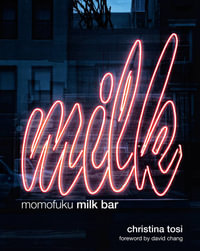
BLACK FRIDAY
Hardcover
RRP $49.99
$19.95
OFF

BLACK FRIDAY
Hardcover
RRP $55.00
$13.75
OFF
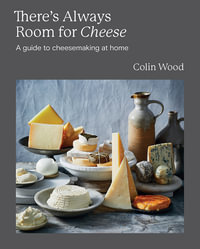
BLACK FRIDAY
RRP $50.00
$25.00
OFF

BLACK FRIDAY
RRP $76.00
$22.80
OFF

